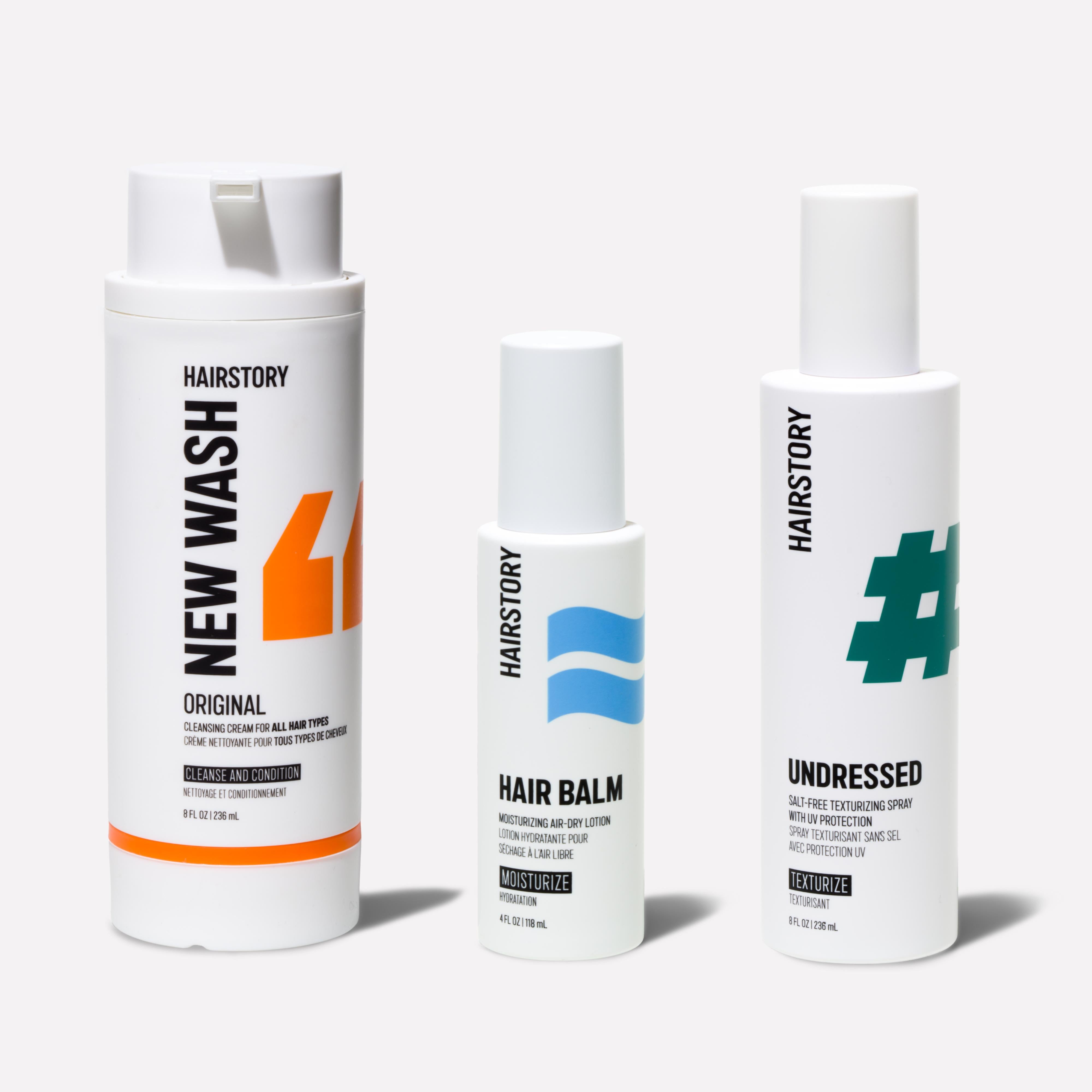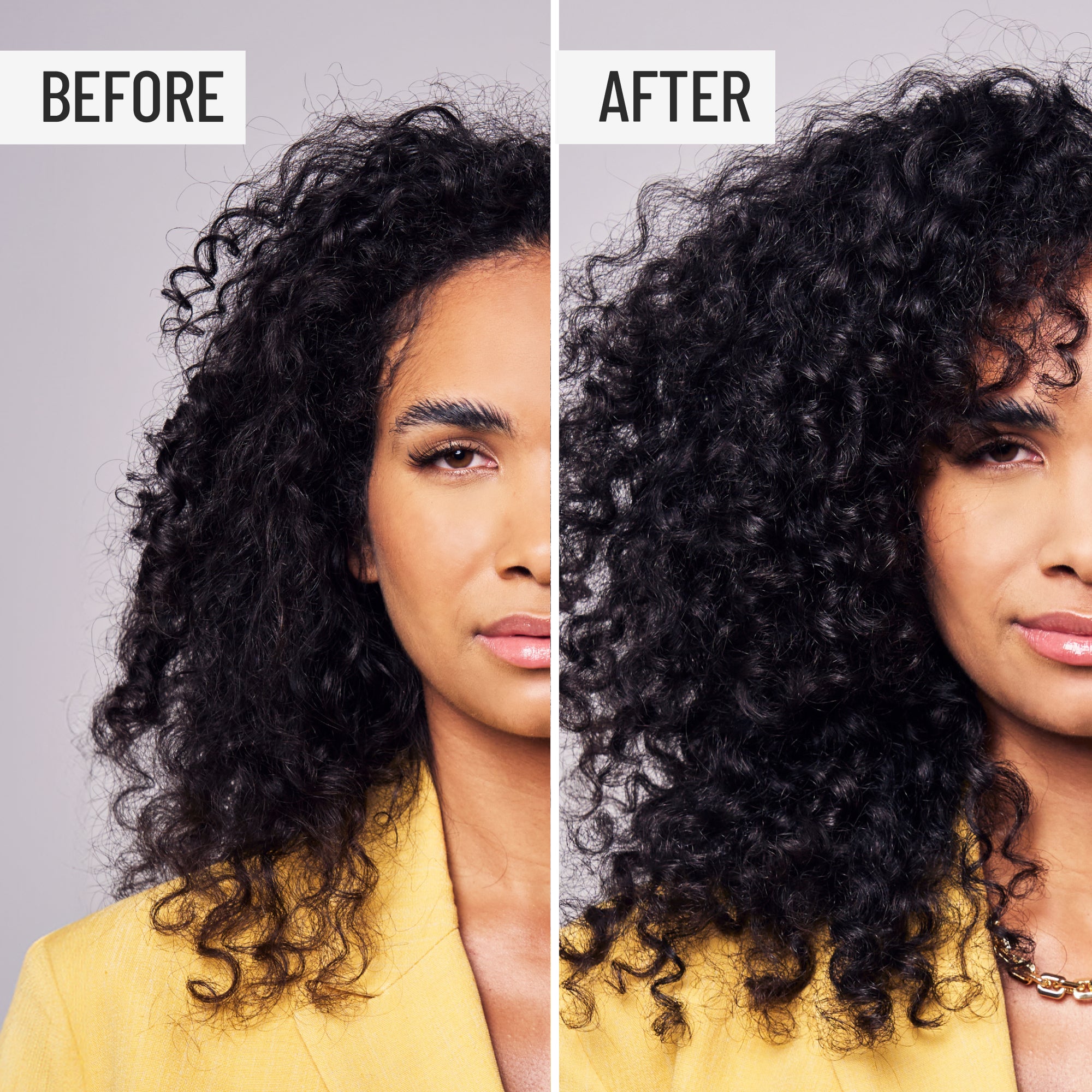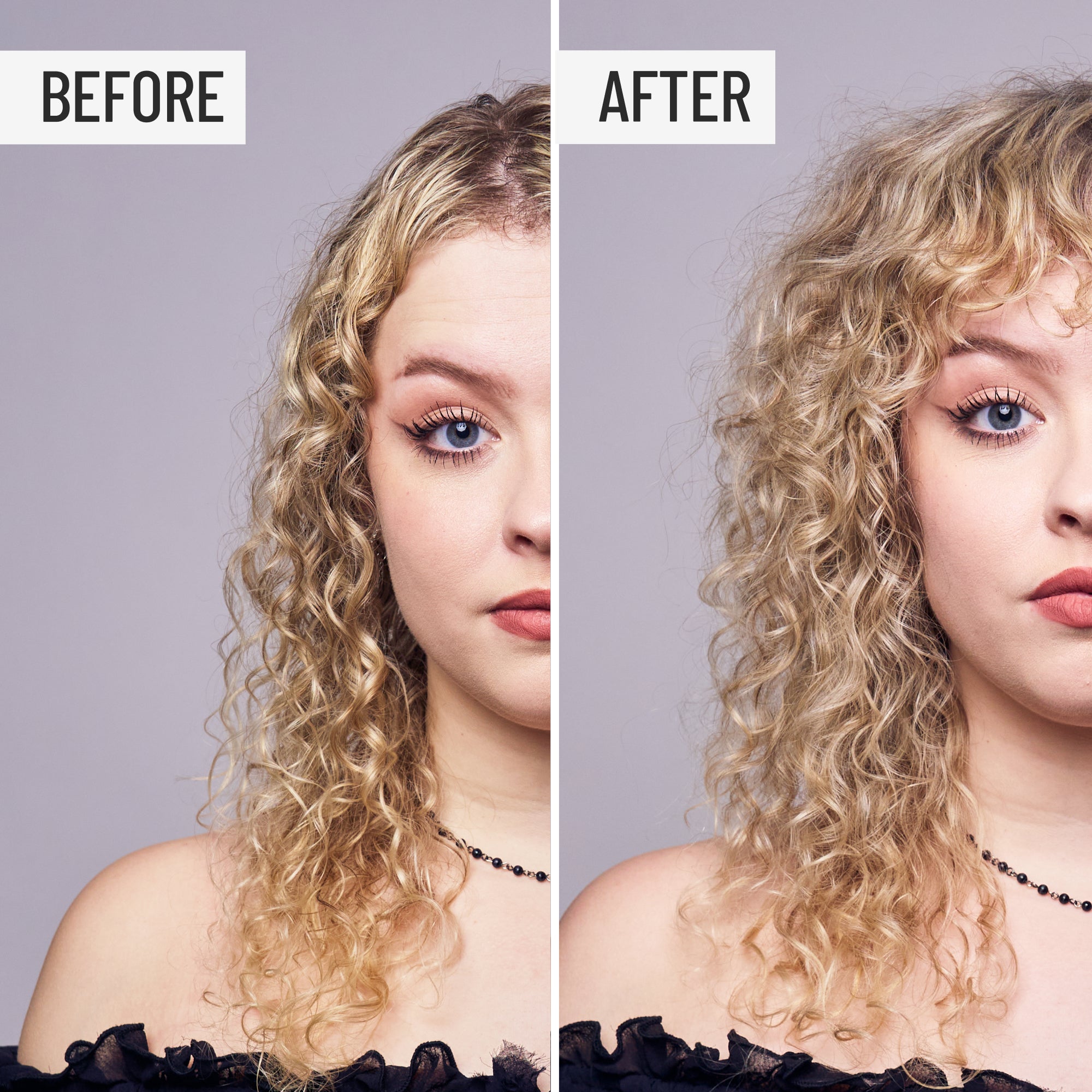Coarse is an inelegant word for hair strands that are larger than average in diameter, or thicker. Coarse hair isn’t a problem to be corrected or a condition to be relieved; it’s simply a fact of nature and genetics.
However, if you’re on the coarse end of the hair spectrum, you’re probably craving some advice on how to best care for it and make it feel softer and a little less wiry. Read on.
WHAT IS COARSE HAIR?
First, let’s clear up the common confusion: There is a difference between ‘coarse’ and ‘thick.’ While ‘coarse’ or ‘fine’ describes the size of each strand, ‘thick’ describes the density of hair follicles on your scalp, or how closely together hair grows. Thick hair has more follicles per square inch than sparser hair does and is more luxuriant overall. Everyone has their own combination of diameter and density.
There is a difference between ‘coarse’ and ‘thick.’ While ‘coarse’ or ‘fine’ describes the size of each strand, ‘thick’ describes the density of hair follicles on your scalp.
Coarse hair feels substantial between your fingers. The standard is the comparison to a length of ordinary sewing thread; if a hair strand feels as thick or thicker than thread, it’s on the coarse side. Coarse hair can be straight, it can be curly, wavy, kinky, and any hair texture in-between. If your hair takes a longer time to dry, it is most likely coarse. If you’re still unsure about your hair type, take this hair quiz to find out so that you can begin practicing the best hair care methods!
COARSE HAIR IS A GIFT
There is no reason, though, why these more coarse strands can’t look fantastic, hold a hairstyle well, or appear healthy and strong. In fact, you have an advantage on that last count: Thicker hair has well-developed constituent parts.
At the center is the medulla, which is where the core fibers live and is underdeveloped or even absent in very fine hair. Surrounding the medulla is the cortex that gives hair its shape and elasticity. Protecting the cortex on the surface is the cuticle, the protective armor that sheathes each hair shaft composed of overlapping shingles or scales. When managed properly, coarse hair can hold a curl or style well, and be healthy and strong.
If your hair has become coarse over time and wasn’t always so naturally, you may be experiencing a side effect of prescription drugs, such as steroids and hair growth medications, or a hormone imbalance or thyroid condition. Check with your doctor. Sometimes coarse hair isn’t the result of medication, but rather the result of silver gray hair, but can be cared for just the same.
HOW TO WASH AND TAKE CARE OF COARSE HAIR
There are several ways to enhance the health and manageability of your natural hair. For us, first on the list is to stop using traditional shampoo. Coarse hair tends to dry out, especially if it’s curly. Detergents found in conventional shampoos strips hair of its natural oils, and further dry hair out. When learning how to take care of curly hair, or any other hair type, try eliminating traditional shampoo altogether.
Instead, consider alternative washing methods such as the low-poo method that limits the use of detergent; the no-poo method that avoids it altogether; or co-washing – short for conditioner-only washing, which means using oils in conditioner to dissolve your natural oil.
There are ways to enhance the health and manageability of your natural hair. First on the list is to stop using traditional shampoo.
The best of these methods and the easiest to adopt is a 2-in-1 formula or a cleansing conditioner that does both simultaneously while preserving all the natural oils your hair depends on. New Wash Rich is made for hair that needs an extra dose of moisture and is the perfect companion for curly or coily hair.
HOW TO KEEP COARSE HAIR SOFT AND SILKY
To help coarse hair feel more supple and silky, we recommend using a water-based leave-in conditioner that contains essential oils and ‘good’ fats. These products help the cuticles stay closed and tightly sealed tight to keep hair shiny by giving it a smooth surface to reflect light.
More important, cuticles act as a protective barrier, helping hair maintain the proper balance of moisture and hydration. Moisture refers to the oils and lipids that are essential to hair health, and hydration refers to water that hair absorbs and releases not only in the shower, but also in the air.
Moisture refers to the oils and lipids that are essential to hair health, and hydration refers to water that hair absorbs.
Look for leave-in conditioning creams that contain glycerin and essential oils such as Hair Balm that go a long way toward controlling frizz. The good news for coarse hair types is that you needn’t be concerned about products weighing your hair down unlike the fine-haired folks who seek lightweight products and use them sparingly to avoid falling flat.
EMBRACE GOOD ALCOHOLS
Alcohol is a core ingredient in many hair products, but do not let the word categorically scare you. Some forms of alcohol are actually beneficial fatty alcohols that mimic the body’s natural lipids and are often used as emollients in hair care products. Look for these good ones:
- Cetyl Cetearyl Alcohol is vegetable-derived and helps to soften and provide a lotion-like feel without greasiness.
- Cetearyl Alcohol is also vegetable-derived and is an exceptional emulsifier for oil and water, and has conditioning properties.
- Stearyl Alcohol lends a smooth, soft feeling to the hair shaft by helping the cuticle lay flat on the surface.
SLEEP ON SILK
No, this isn’t a princess-and-pea thing, it’s a way to reduce friction, frizz, snarls, and damage. A silk pillowcase won’t “grab” like cotton can, and absorbs less moisture, which means it may help your hair retain the natural oil (sebum) it craves. Be sure to buy pure silk and avoid “silk-like” fabrics.
COOL THE HOT TOOLS
The overuse of heat styling tools can rob any hair type of essential moisture and exert avoidable mechanical stress. Because your strands are thicker, you’ll need to work with smaller sections of hair so you can fully heat the hair without going over the same area more than once.
There are 4 factors to consider if you must use heat to get the results you want:
- Dampness: Towel-dry your hair thoroughly so it’s damp, not wet, before flipping the switch. Blow-drying sopping wet hair only prolongs the time your hair is exposed to heat, and can actually boil water that may have been absorbed into the hair shaft and cause breakage.
- Duration: Keep your heat styling routine short. Plan what you want to accomplish and get it done efficiently to minimize exposure. Also, keep the blow dryer nozzle at least 6 inches away from your head, and don’t linger too long on one spot.
- Frequency: Hair that is well-conditioned can look great without altering it with heat, and natural texture – anything but stick-straight hair– is far more welcome today than it used to be. Gone are the days when natural curl is perceived as out of control or unprofessional. Learn to love your curl!
- Protection: Use a thermal protectant that helps hold the hairstyle you’re creating while also preventing damage. Don’t assume, however, that this gives you license to burn – use all precautions. We recommend a cream that contains copolymers, proteins, and essential oils – to both insulate hair and stem moisture loss. Dressed Up should fill all your heat-styling needs.
Finally, pull the plug on appliances at the first signs of chronic dryness or split ends. In fact, the best way to dry hair is to let it air-dry all on its own. This is especially important when learning how to take care of long hair to avoid split ends or breakage.
BRUSH WISELY
Coarse hair is best brushed – gently – when damp to help minimize frizz, flyaways, and tangling as it dries. Brushing damp hair helps the scalp provide an essential function to the lengths of your hair strands: pulling down the sebum it secretes that is your own best conditioner and the essential stuff that keeps hair well-oiled, and well-sealed.
A high-quality boar-bristle/nylon combination is something everybody should have in their hair care kit. A round brush is useful mainly for adding “bend” or curves to a blow-dry, and a flat brush is the most versatile. Mason Pearson recommends their nylon bristles for the coarsest hair types. Size of brush will depend on your density: the thicker the bigger.
BOTANICAL OILS
Look for conditioning and styling products that contain these hair-friendly oils to keep your strands well-fed, and help fight frizz and dryness:
- Jojoba oil
- Evening primrose oil
- Sunflower oil
- Olive oil
- Avocado oil
- Sweet almond oil
- Coconut oil
SAY HELLO TO ALOE
We reserve a special section for this amazing ingredient with many talents, including cleansing, soothing, and improving signs of damage to the hair and scalp resulting from the daily grind or feats of styling. It’s worth giving this a read to learn more.
MIND YOUR NUTRITION
There is a lot you can do from the outside in, but there’s nothing like addressing hair health from the inside out. What you feed your body also affects your hair, and a deficiency can affect both hair growth and condition.
Nuts, seeds, fruits, vegetables, lean protein, and healthy fats all support healthy hair, although eating the same few foods over eventually limits the absorption of nutrients when your body has had enough. Protein is key, not surprisingly, as hair consists primarily of protein, and the lack of it can result in thinning.
Look for foods that are rich in zinc, such as oysters and pumpkin seeds; omega-3 fatty acids, such as salmon, sardines, navy beans, flaxseed oil, chia seeds; and biotin from eggs.
Foods full of vitamin C – citrus, Brussels sprouts, broccoli, red pepper, kale, strawberries, and kiwi – have antioxidant properties to protect your follicles from free-radical damage that inhibits healthy growth. Vitamin C also plays an important role in producing collagen for stronger hair.
In general, opt for whole, unprocessed foods. And drink plenty of water!
TRIM IT UP
Getting a haircut or trim every so often is an important part of hair care. Keep split ends in check by trimming them every quarter or so, especially if you have curly hair, which is more prone to them. Frayed ends can lead to hair fibers unraveling upwards along the shaft – irreparable damage. Shears are, in fact, your friends.
Frayed ends can lead to hair fibers unraveling upwards along the shaft – irreparable damage. Shears are, in fact, your friends.
To recap, coarse hair has strands that are thicker than other hair types, regardless of how densely spaced your hair follicles are each hair follicle is, and you’re the envy of people with fine hair who often struggle to get their hair to look voluminous. The other side of the fence is always greener, but be grateful that you’re on the side with lots of body.
While coarse hair is generally quite robust and not nearly as vulnerable as more delicate types, all hair should be treated like the fine fabric it is and handled with care. Too much heat and too much styling will make it become dry, brittle, frizzy, and every bit as fragile.































